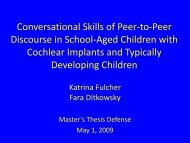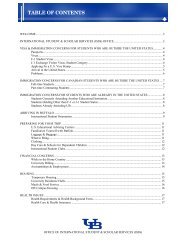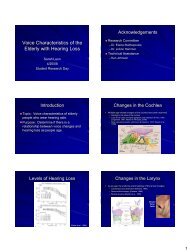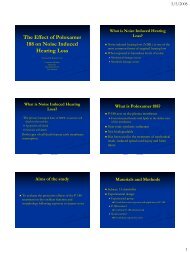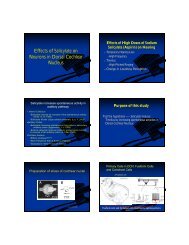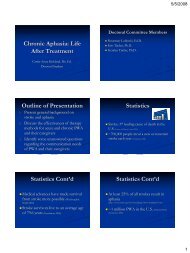Speech Disruptions in the Narratives of English-Speaking Children ...
Speech Disruptions in the Narratives of English-Speaking Children ...
Speech Disruptions in the Narratives of English-Speaking Children ...
You also want an ePaper? Increase the reach of your titles
YUMPU automatically turns print PDFs into web optimized ePapers that Google loves.
seven age levels (i.e., from k<strong>in</strong>dergarten to high school<br />
seniors). In general, younger age groups tended to produce<br />
more silent pauses and longer silent pause duration<br />
(measured by silent pause length per syllable) than<br />
older age groups. It was suggested that younger children<br />
needed more time for plann<strong>in</strong>g language production than<br />
older age groups.<br />
Wijnen (1990) analyzed <strong>the</strong> frequency and distribution<br />
<strong>of</strong> speech disruptions <strong>in</strong> a typically develop<strong>in</strong>g Dutch<br />
child between <strong>the</strong> ages <strong>of</strong> 2;4 (years;months) and 2;11.<br />
The frequency <strong>of</strong> speech disruptions <strong>in</strong>creased <strong>in</strong>itially<br />
and <strong>the</strong>n subsequently decl<strong>in</strong>ed. In addition, speech disruptions<br />
were randomly distributed with<strong>in</strong> sentences at<br />
<strong>the</strong> first half <strong>of</strong> <strong>the</strong> observation period but tended to concentrate<br />
at phrase boundaries or sentence boundaries at<br />
<strong>the</strong> second half. Wijnen concluded that <strong>the</strong> decrease <strong>of</strong><br />
speech disruptions was related to <strong>the</strong> abundant use <strong>of</strong> a<br />
few syntactic frames (e.g., Pronoun + Verb + X ) as grammar<br />
developed. The frequent use led to an <strong>in</strong>crease <strong>of</strong><br />
automaticity <strong>of</strong> <strong>the</strong>se frames <strong>in</strong> sentence formulation<br />
and reduced <strong>the</strong> risk <strong>of</strong> disruptions (Wijnen). In addition,<br />
speech disruptions were concentrated at phrase and sentence<br />
boundaries because <strong>the</strong>se were <strong>the</strong> locations where<br />
language plann<strong>in</strong>g took place, which reflected <strong>the</strong> emergence<br />
<strong>of</strong> a sentence formulation system <strong>in</strong> this child.<br />
Colburn and Mysak (1982) exam<strong>in</strong>ed <strong>the</strong> semantic–<br />
syntactic structures (e.g., locative + action, wh-question)<br />
<strong>of</strong> dysfluent utterances <strong>in</strong> longitud<strong>in</strong>al samples <strong>of</strong> 4 children<br />
from MLU Level I–IV. Novel semantic–syntactic<br />
structures that were just emerg<strong>in</strong>g provoked more dysfluencies<br />
than <strong>the</strong> structures that had recently emerged<br />
or were consistently used <strong>in</strong> <strong>the</strong> child’s language sample.<br />
Colburn and Mysak concluded that novel structures<br />
tended to precipitate dysfluencies because <strong>the</strong>se structures<br />
were not fully practiced and hence placed high<br />
l<strong>in</strong>guistic stress <strong>in</strong> sentence formulation.<br />
Rispoli and Hadley (2001) <strong>in</strong>vestigated <strong>the</strong> relationship<br />
between speech disruptions, sentence length, and<br />
complexity <strong>in</strong> children from 2;6 to 4;0 years. Their results<br />
<strong>in</strong>dicated that dysfluent sentences tended to be<br />
longer and more complex than fluent ones. With <strong>the</strong> development<br />
<strong>of</strong> <strong>the</strong> child’s grammar, <strong>the</strong> gap <strong>in</strong> complexity<br />
between <strong>the</strong> dysfluent and fluent sentences expanded<br />
even when length effect was partialed out. Rispoli and<br />
Hadley (2001) <strong>the</strong>refore argued that as grammatical development<br />
proceeded, speech disruptions tended to appear<br />
<strong>in</strong> more-complex sentences. When a higher level <strong>of</strong><br />
sentence complexity emerged, <strong>the</strong> sentence production<br />
mechanism was slow and <strong>in</strong>efficient, trigger<strong>in</strong>g a high<br />
rate <strong>of</strong> speech disruptions. With development, complex<br />
sentences became more automatic, trigger<strong>in</strong>g speech disruption<br />
less <strong>of</strong>ten. In a similar ve<strong>in</strong>, Rispoli and Hadley<br />
(2005) conducted a longitud<strong>in</strong>al study to <strong>in</strong>vestigate<br />
<strong>the</strong> relationship between speech disruptions and <strong>the</strong><br />
acquisition <strong>of</strong> tense and agreement markers (i.e., third<br />
person s<strong>in</strong>gular –s, past tense –ed, and copula BE). The<br />
results showed that <strong>the</strong> disruption rate <strong>in</strong> sentences with<br />
tense and agreement markers decreased as <strong>the</strong> child’s<br />
productive level <strong>of</strong> <strong>the</strong>se markers (Hadley & Short, 2005)<br />
<strong>in</strong>creased. It was aga<strong>in</strong> argued that <strong>the</strong> decrease <strong>in</strong> disruptions<br />
<strong>in</strong> sentences with tense and agreement markers<br />
wasrelatedto<strong>the</strong><strong>in</strong>crease<strong>in</strong>automaticity<strong>of</strong>those<br />
markers.<br />
In summary, evidence from typically develop<strong>in</strong>g children<br />
suggests that speech disruptions decrease with syntactic<br />
development. An <strong>in</strong>crease <strong>in</strong> <strong>the</strong> automaticity <strong>of</strong><br />
syntactic knowledge may reduce <strong>the</strong> risk <strong>of</strong> disruptions.<br />
Although not addressed <strong>in</strong> <strong>the</strong>se studies, lexical development<br />
may also play a role <strong>in</strong> speech disruptions. Evidence<br />
from adult language production shows that some<br />
speech disruptions stem from problems <strong>in</strong> lexical retrieval<br />
(Levelt, 1989; Maclay & Osgood, 1959). The ability<br />
to retrieve lexical items is related to <strong>the</strong> depth <strong>of</strong><br />
knowledge <strong>in</strong> <strong>the</strong> semantic lexicon (McGregor, Newman,<br />
Reilly, & Capone, 2002). As <strong>the</strong> degree <strong>of</strong> semantic knowledge<br />
becomes enriched, children are able to retrieve lexical<br />
items more easily and efficiently, and disruptions<br />
due to difficulty <strong>in</strong> lexical retrieval may decrease. We<br />
<strong>the</strong>refore make <strong>the</strong> assumption that <strong>the</strong> production <strong>of</strong><br />
speech disruptions <strong>in</strong> developmental language is related<br />
to general language ability (i.e., strength <strong>of</strong> l<strong>in</strong>guistic<br />
representations), <strong>in</strong>clud<strong>in</strong>g lexical and syntactic abilities.<br />
Two questions arise here: How are sentences produced<br />
from a representation <strong>of</strong> l<strong>in</strong>guistic and nonl<strong>in</strong>guistic<br />
knowledge, and how do weak l<strong>in</strong>guistic representations<br />
result <strong>in</strong> disruptions <strong>in</strong> language production To<br />
answer <strong>the</strong>se questions, we need to consider how preverbal<br />
messages are grammatically encoded (Bock &<br />
Levelt, 1994; Levelt, 1989). When a speaker <strong>in</strong>tends to<br />
express a message such as Theboyeats<strong>the</strong>cakes,he<br />
first builds up a nonl<strong>in</strong>guistic representation <strong>of</strong> this<br />
message. The preverbal message is <strong>the</strong>n translated <strong>in</strong>to<br />
l<strong>in</strong>guistic forms by grammatical encod<strong>in</strong>g. At grammatical<br />
encod<strong>in</strong>g, <strong>the</strong> speaker needs to retrieve lemmas from<br />
<strong>the</strong> lexicon, code specific <strong>in</strong>formation for <strong>the</strong>se lemmas<br />
(e.g., def<strong>in</strong>iteness for boy; person, number and tense for<br />
eat), and assign <strong>the</strong>m syntactic functions (e.g., subject,<br />
ma<strong>in</strong> verb). The <strong>in</strong>formation <strong>of</strong> lemmas and <strong>the</strong>ir syntactic<br />
functions, <strong>in</strong> turn, guides <strong>the</strong> activation <strong>of</strong> syntactic<br />
frames or phrase structures for position<strong>in</strong>g <strong>the</strong>se<br />
lemmas (Bock & Levelt, 1994). For <strong>in</strong>stance, a syntactic<br />
frame with <strong>the</strong> def<strong>in</strong>ite article <strong>the</strong> is built up for <strong>the</strong><br />
lemma boy and is located at <strong>the</strong> subject position <strong>in</strong> a sentence<br />
because <strong>the</strong> lemma boy is attached with a feature<br />
<strong>of</strong> def<strong>in</strong>iteness and is assigned <strong>the</strong> syntactic function <strong>of</strong><br />
subject. It should be noted that this model (Bock & Levelt,<br />
1994; Levelt, 1989) permits <strong>in</strong>cremental production—<br />
that is, a sentence can be processed <strong>in</strong> <strong>in</strong>crements or<br />
724 Journal <strong>of</strong> <strong>Speech</strong>, Language, and Hear<strong>in</strong>g Research • Vol. 51 • 722–738 • June 2008<br />
Downloaded from jslhr.asha.org on November 10, 2010



